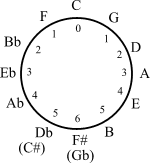Group theory
Group theory is a branch of abstract algebra concerned with the study of groups. Groups are sets equipped with an operation that combines any two of its elements to form a third element in such a way that four conditions known as the group axioms are satisfied: closure, associativity, the identity element, and the inverse element. The study of groups is a fundamental part of mathematics, with applications across a wide range of disciplines including physics, chemistry, and computer science.
Definition[edit | edit source]
A group (G, *) is defined as a set G together with an operation * that combines any two elements a and b to form another element, denoted a*b. The operation must satisfy four requirements known as the group axioms:
- Closure: For all a, b in G, the result of the operation a*b is also in G.
- Associativity: For all a, b, and c in G, the equation (a*b)*c = a*(b*c) holds.
- Identity element: There exists an element e in G such that for every element a in G, the equation e*a = a*e = a holds.
- Inverse element: For each a in G, there exists an element b in G such that a*b = b*a = e, where e is the identity element.
Types of Groups[edit | edit source]
Groups can be classified into several types based on their properties:
- Finite groups: Groups with a finite number of elements. The number of elements is called the order of the group.
- Infinite groups: Groups with an infinite number of elements.
- Abelian groups: Groups where the operation is commutative, meaning a*b = b*a for all a, b in G.
- Non-abelian groups: Groups where the operation is not necessarily commutative.
- Cyclic groups: Groups that can be generated by a single element.
Applications[edit | edit source]
Group theory has wide-ranging applications in many areas of mathematics and science:
- In mathematics, it is used to study symmetry in geometry and to solve polynomial equations in algebra.
- In physics, group theory underpins the fundamental laws of quantum mechanics and relativity, providing a framework for understanding the symmetries of the laws of nature.
- In chemistry, it helps explain the structures of crystals and molecules and the symmetries in chemical reactions.
- In computer science, groups are used in the study of cryptography, coding theory, and algorithm design.
History[edit | edit source]
The origins of group theory can be traced back to the 19th century, with significant contributions from mathematicians such as Évariste Galois, who introduced the concept to study the solvability of polynomial equations. The development of group theory was further advanced by mathematicians like Arthur Cayley, who formalized the definition of abstract groups, and Felix Klein, who used group theory in his study of geometric symmetries, leading to the famous Erlangen program.
See Also[edit | edit source]
Navigation: Wellness - Encyclopedia - Health topics - Disease Index - Drugs - World Directory - Gray's Anatomy - Keto diet - Recipes
Search WikiMD
Ad.Tired of being Overweight? Try W8MD's physician weight loss program.
Semaglutide (Ozempic / Wegovy and Tirzepatide (Mounjaro / Zepbound) available.
Advertise on WikiMD
WikiMD is not a substitute for professional medical advice. See full disclaimer.
Credits:Most images are courtesy of Wikimedia commons, and templates Wikipedia, licensed under CC BY SA or similar.Contributors: Prab R. Tumpati, MD





